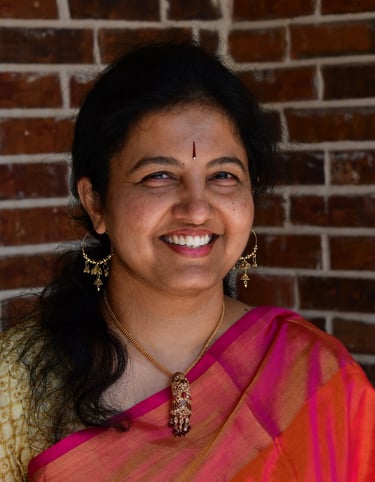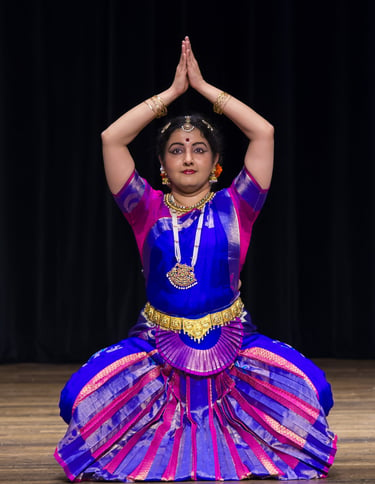BHAAVA SANGAMA PROGRAM
Introduction
It is with immense joy and reverence that we gather here today to celebrate the timeless beauty of Kannada literature and poetry, brought to life through the graceful art of Bharatanatyam.
Bharatanatyam is a very familiar art form for most of you. But for those that are new to this, Bharatanatyam is one of India’s oldest classical dance forms, born in the temples of Southern India over two thousand years ago. What began as a sacred ritual has evolved into a classical and dynamic art form performed on stages across the world today. Rooted in a deeply spiritual context — like much of India’s artistic tradition — Bharatanatyam tells stories not just through movement, but through the eyes, the hands, and even silence. Every gesture is a word; every step, a sentence. It blends intricate footwork, dramatic expression, and emotional depth to bring mythology and philosophy to life. Bharatanatyam is not just about tradition — it’s about connection. Whether performed to ancient hymns or contemporary interpretations, it continues to speak across time, culture, and language.
In this unique confluence of two rich traditions—Kannada literary heritage and the classical dance form of Bharatanatyam—we embark on a journey that bridges the soul-stirring verses of poets and the evocative movements of dance. Kannada literature, known for its depth, wisdom, and evocative beauty, has inspired generations, and tonight, we pay homage to its poets, its language, and its enduring legacy.
Through the lens of Bharatanatyam, we delve into the vivid emotions, imagery, and stories that have shaped Kannada literature. From the works of the great Kuvempu, DVG, Pu Ti Narasimhachar, of the past to the present to the poignant expressions of poetry, each performance tonight will not just tell a story, but also connect us to the very essence of Kannada culture—its heart, its spirit, and its voice. This evening is thus a presentation of the transcendental wisdom, combined with that of the present – Smriti Prastuti.
Let us embark on this journey where poetry moves, and dance speaks, as we honor the wisdom of Kannada literature and the timeless grace of Bharatanatyam.
Thank you.
Dance 1: Invocation
Our first presentation this evening begins with an invocation, followed by the heartfelt aspirations of a poet. Drawn from the works of Kuvempu, the pride of Karnataka, this piece is a prayer to the divine — a request for blessings as the poet, embodied here by the dancer, who embarks on a journey of art and rasa.
With humility, the poem calls upon the supreme light — a force beyond time, language, and place. It seeks guidance to lead a life of virtue, filled with noble deeds, and dreams of seeing the Kannada language rise to new heights, carrying forward the wisdom of generations.
Let us now enter this sacred space where the poet’s words and the dancer’s movements come together — in reverence, in aspiration, and in grace.
Dance 2: Thodaya Mangalam - Jaya Janaki Kantha
Purandara Dasa, often regarded as the father of Carnatic music, was a prominent saint-poet of the 14th century and one of the most important figures in Kannada literature. His devotional hymns dedicated to Lord Vishnu and his incarnations, were written in simple yet profound language thereby popularizing the bhakti (devotion) movement in Karnataka and enriching the Kannada literary and musical traditions.
Jaya Janaki Kantha is one of many devotional compositions by Purandara Dasa that praises Lord Rama as the beloved consort of Sita (Janaki) and the divine protector of all. The song expresses deep reverence for Lord Rama’s virtues—his compassion, strength, and righteousness—and celebrates his role as the protector of devotees. It is a powerful invocation of divine grace and protection, encapsulating both the bhakti and cultural pride of the Karnataka region.
Dance 3: Mamateya Suli Manthare
Valmiki’s Ramayana is the original Sanskrit epic that has shaped Indian thought, culture, and art for thousands of years. In the modern era, Kuvempu, the iconic Kannada poet, reimagined this story through a philosophical lens in his literary masterpiece, Ramayana Darshanam.
While Valmiki tells the tale as a divine and moral journey, Kuvempu goes deeper — exploring its human complexity, its emotional truths, and the unseen cosmic forces that guide our actions. His work invites us not just to hear the Ramayana, but to see it — to reflect on the subtle forces at play in every character’s journey. One such character is Manthare. We often remember her simply as the wicked one who convinced Kaikeyi to send Rama into exile. But Kuvempu paints a richer picture — one of a woman shaped by love, loss, and society’s rejection. Manthara was a discarded child, taken in by Kaikeyi’s father. Marked by physical deformities, she was scorned by society despite the king’s protection. The only affection she ever knew came from Kaikeyi and her son Bharata, to whom she gave her full, unquestioning love. That love, Kuvempu suggests, is what ultimately clouds her judgment — not malice.
In one poetic moment, Kuvempu imagines young Rama sitting with his mother Kausalya. When Rama sees the moon and longs to hold it, he begins to cry inconsolably when told he cannot. Into this scene walks Manthara, carrying baby Bharata. She quickly understands and hands Kaikeyi a mirror to reflect the moonlight for Rama. The child is delighted. The household rejoices, but when Manthara reaches out to hold Rama, she is pushed away — scorned as a bearer of misfortune. Her act of kindness is forgotten, and her wound grows deeper.
Kuvempu writes that her deformities are not her own, but rather a reflection of society’s own failings — its inability to see beauty beyond the surface. This dance explores Manthara as someone inherently kind, whose path is twisted not by evil, but by years of rejection. He also reminds us that we are all part of something greater — puppets in the hands of the divine, tied together in an unseen weave. Manthara, too, is a part of that cosmic story.
Later in the story, Manthara dreams of Kaikeyi — old, widowed, and wandering through a forest with Bharata. She wakes to find Ayodhya celebrating Rama’s coronation. Struck by fear and driven by her overwhelming love for Kaikeyi and Bharata, she rushes to Kaikeyi’s chambers, urging her to act. She advises Kaikeyi to ask for Bharata’s coronation and 14 years of exile to Rama. And so, the great turning point of the Ramayana begins.
This is the heart of what I will be presenting today. The seed to choreograph for this literary work was planted by my mother nearly a decade ago, and nurtured by my father’s encouragement. It has quietly grown within me, waiting for the right moment to take form.
Adapting Kuvempu’s work into dance — especially something so layered and philosophical — has been a challenge I’ve embraced with reverence and care. I am grateful to Rohit Bhat and the orchestra for understanding the emotion behind the words and bringing them to life through music.
This work is choreographed in a dance-drama format, and it is with great joy and humility that I now share it with all of you.
Dance 4: Kolala Kare
“Krishnana Kolalina Kare” is a mesmerizing Kannada song that celebrates the enchanting and hypnotic call of Lord Krishna’s flute. The music and lyrics by P. T. Narasimhachar evoke the magical power of the flute’s melody. When the gopis (group of young women) hear Krishna’s flute, they forget their crying babies, their husbands, their chores, and even the act of getting dressed. Just as the morning sun brightens the entire sky, Krishna’s flute fills the heart and body with pure love, washing away all fear and doubts. The music flowing from the flute is the life-giving energy of love itself, drawing listeners into a deep, spiritual trance. It symbolizes the divine attraction Krishna’s music holds over all beings, inviting them to surrender and experience blissful love and devotion beyond words.
Dance 5: Kaadiruvalu Shabari
Kaadiruvalu Shabari by V. Seetaramayya is a poignant devotional poem that reimagines the story of Shabari from the Rāmāyaṇa with quiet intensity and spiritual depth. In contrast to portrayals of grand or heroic devotion, this poem highlights the silent, enduring faith of a simple woman who waits for years in the forest for Lord Rāma’s arrival. Through vivid imagery—her careful gathering of sweet berries, whispered prayers, and humble offerings—the poem celebrates a love and devotion that is pure, unshaken, and deeply personal. It reminds us that true spirituality lies beyond social hierarchy and ritual—it is rooted in sincerity, patience, and the heart’s longing for the divine.
The poem also offers a universal message: that the world itself seems to echo Shabari’s hope—the hope that Rāma, the savior, will come to those who truly seek him. This waiting is not passive; it is a deeply spiritual act, soaked in surrender and unwavering trust.
The poem's emotional arc is beautifully extended through choreography that traces Shabari’s spiritual journey from her youth. It begins with her moral awakening—when, on learning that her wedding would require the killing of innocent animals for a feast, she chooses to leave her community in search of a more compassionate path. She finds refuge in the ashram of Sage Matanga, whose quiet teachings and presence guide her transformation. Shabari's soul becomes steeped in the essence of the divine. Before his death, her guru (teacher) assures her that Rāma will come—and with that promise, she waits.
This poetic retelling becomes not just Shabari’s story, but a symbol of all seekers on the path: those who wait, who love, who believe—until grace finally arrives.
Dance 6: Kagga lahari
Up next is the concluding piece. Three kaggas are choosen from the timeless work collection of Mankutimmana Kagga by D. V. Gundappa—fondly known as DVG interwoven with rhythmic sequences.
Though first published in the early 1940s, these verses continue to speak to us today. They reflect life’s deepest truths in the simplest of words. This prastuti, or presentation, is not just an artistic offering—it feels prastuta, timely and deeply needed in today’s world.
Each kagga offers a window into everyday wisdom:
The first verse urges humility—reminding us that like the silent blooming of a flower or the steady light of the sun, true greatness requires no applause.
The second calls for balance: to be gentle at home, resilient in hardship, and kind to the vulnerable—living with strength, grace, and unity.
The third encourages openness: to learn freely, live generously, and embrace wisdom, so that even death loses its grip.
This segment ends with a Sanskrit prayer—“Lead us from untruth to truth, from darkness to light, and from death to immortality”—a call for inner liberation and clarity.
Sapna is the Artistic Director of Upaasana School of Dance, where she teaches and creates compelling Bharatanatyam choreoraphies. Sapna is trained in Pandanallur style of Bharatanatyam under the able guidance of Gurus Late Vid. U. K Arun and Vid Smt Savita Arun from Bangalore, India. Her journey in the field of dance started at the age of five. Her Arangetram at age nine was widely published and discussed in the dance circles of Bangalore.
Known for her Abhinayas or expressions, Sapna has an innate ability to communicate with the audience and keep them engaged, which now is being passed on to her students at the Upaasana School of Dance in Dallas, TX.
In the past four decades Sapna has given many performances for prestigious organizations both in India and the US, which includes the Indian television network Doordarshan, Karnataka Chitra Kala Parishat, Karntaka Nritya Kala Parishat, Kinkini Nrityotsava and for many charitable events and organizations in the US such as, DART, Trammel Crow Arts, Discover India, to name a few.
Apart from this, Sapna has also choreographed dance productions namely Pancha Bhoothas, Krishnam Vande, Dashaavataara, and Shivoham. Her production, Pancha Bhoothas was created to raise funds to aid tsunami victims of 2004. .



